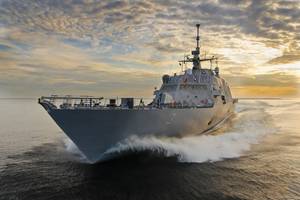-

Green Marine: Electrification is the Power behind ‘Future-Proofing’
There's an “electrification of the seas” happening for navies around the world.Whether it's to achieve greater military capabilities, operational economics and efficiencies or to be better stewards of the environment.There's a trend moving from direct mechanical drives towards more flexible electrical propulsion systems. Ships can still have the same propellers and engines, but they now have a much more flexible power system architecture that benefits design…
-

US Navy: Bigger is Better, but at What Cost?
The U.S. Navy has a balanced fleet, but it wants to grow bigger and better. Will the budget allow both? Maritime Reporter's March 2017 cover story on the U.S. Navy was all about the numbers. There exists several plans to grow the fleet beyond the current number of 308 ships, the Mitre recommendation of 414 ships, the Center for Strategic and Budgetary Assessment 340-ship proposal, and the Navy’s decision to grow the fleet to 355 ships, and the Trump administration’s 350.
-

First Nuclear-Powered Carrier Completes Last Deployment
“Nearly everything that can be said about this ship must be done in superlatives or in terms of the first, the largest, the fastest, greatest striking capability and highest operational flexibility.” - Secretary of the Navy John Connally, USS Enterprise commissioning ceremony, Nov. The USS Enterprise (CVN 65) is used to being first, biggest, fastest, and best. Now she can add “last” to her impressive list of accomplishments…
-

U.S. Navy Treading Water on Shipbuilding
Fleet, Force put Warfighting First: U.S. At the 200th anniversary of the War of 1812, and with a new Chief of Operations at the helm, the U.S. Navy continues to provide credible combat power with persistent presence around the world. Chief of Naval Operations Adm. Jonathan Greenert has set forth his “Sailing Directions” and “Navigation Plan” for the Navy, which sets forth priorities and informs the budget and acquisition process.
-
Navy, IEEE Keep Electrical Ship Standard Current
It’s been a year since we first told you here in Maritime Reporter about the effort to update and rewrite the IEEE-45 Standard for Electrical Installations on Ships. At that time, we urged qualified experts to offer suggestions and volunteer to join in the effort as members of the committee. Thanks to those who agreed to support the committees work, a great deal of progress has been made, says Moni Islam, chair of the IEEE-45 Standard Coordinating Committee.
-

US Navy: DDG 1000's Composite Deckhouse Milestone
Composite materials are used to make cars, planes and boats, and have been used to build minesweepers and small surface combatants. Now, the largest composite structure ever built—the DDG 1000 destroyer deckhouse—has been fabricated in Mississippi and is being shipped to Maine for assembly aboard the future USS Zumwalt (DDG 1000). In this dramatic example of a “shared build,” General Dynamics Bath Iron Works is the lead yard…
-

Lessons Learned Lead to Improvements in Follow-on LCS Ships
The U.S. Navy and its shipbuilding partners have incorporated lessons learned from the first two Littoral Combat Ships (LCS) in the design and construction of the follow-on ships. “I think the lead ships are pretty good,” says Rear Adm. Jim Murdoch, the Program Executive Officer for LCS (PEO LCS). LCS 1 is the USS Freedom, built at Marinette Marine in Wisconsin by a team led by Lockheed Martin, and commissioned in November of 2008. The ship deployed to U.S.
-

FAST 2011: Focuses on Future of Fast Sea Transportation
Naval Architects and marine engineers from around the world gathered in Honolulu in September for the 11th International Conference on Fast Sea Transportation (FAST 2011). The four-day biannual symposium promoted world-wide cooperation among scientists and engineers involved with all aspects of the high-speed maritime industry. FAST 2011 was the Fast Foundation’s 20th anniversary. Kjell Holden of the Norwegian Univ.
-

ONR: From Science Fiction to Science Fact
As Director of Innovation, Dr. Larry Schuette is one of three portfolio directors at the Office of Naval Research (ONR). His counterparts are the director of research (discovery and invention) and director of transition. The Office of Innovation promotes, fosters, and develops innovative science, technology, processes and policies that support the Department of the Navy. “I manage the ‘leap ahead’ portfolio here at the Office of Naval Research,” he says.
-
FAST 2011: Addressing Speed on the Water
FAST 2011 is the 11th International Conference on Fast Sea Transportation. Started in Trondheim, Norway in 1991, FAST conferences take place every two years and are the world’s leading conferences addressing fast sea transportation issues. Recent FAST conferences were held in Athens, Greece (2009), Shanghai, China (2007), and St. Petersburg, Russia (2005). According to Todd Peltzer, director of programs for Honolulu-based Navatek…


